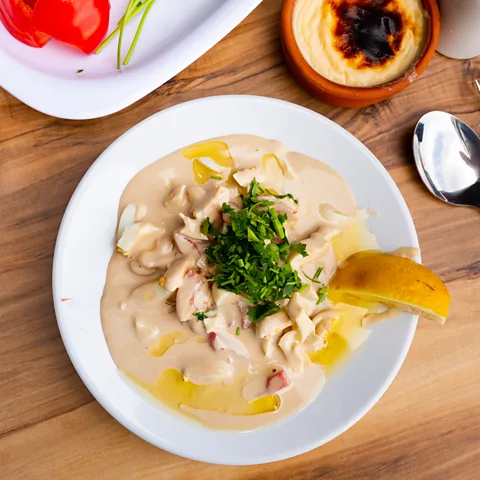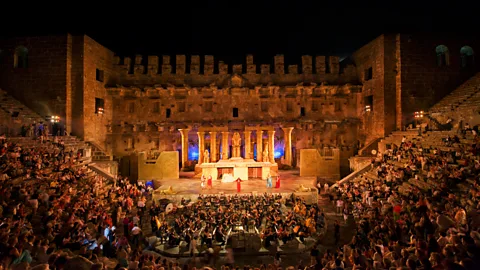 Getty Images
Getty ImagesActor Ekin Koç called seaside Antalya home before conquering the world of Turkish film. Here are his picks, from hiking the Lycian Road to catching a concert at the Aspendos Theatre.
Though its name may be less familiar to overseas travellers than Istanbul, the Turkish resort city of Antalya is no stranger to visitors. Founded by the Ancient Greeks as Attalia in the 2nd Century BCE, Antalya has since been occupied by the Romans, the Seljuk Sultanate and the Ottomans; even withstanding a brief Italian occupation after World War One before Turkey claimed independence. Today, Antalya – the crowning jewel of the Turkish Riviera and, along with Istanbul, one of the world’s most visited cities in 2023 – attracts both families and A-list celebrities with its 2,000-year-old Old Town and stunning turquoise waters.
Sometimes, the celebrity strolling Antalya’s spectacular seashore is actually a native. We caught up with Antalya-born film star Ekin Koç (best known to English-speaking audiences as Turkish business advisor Kadir in HBO’s Succession) to get his take on his beautiful hometown, studded by the Taurus mountains and cradled by the Mediterranean sea.
“If you’re from Antalya, you have a special connection with the sea,” says Koç. “The sea is everywhere. We eat from the sea, we swim, we sit next to the sea. I’ve always loved being in connection with the sea.”

The SpeciaList
Ekin Koç is an Antalya-born actor and musician whose breakout role was Sultan Ahmed I in the Turkish TV series Muhtesem Yüzyil: Kösem. In 2021, his performance in Brother’s Keeper won him Best Supporting Actor at the Ankara International Film Festival and the Antalya Golden Orange Film Festival.
Koç relocated to Istanbul for university and his film career but returns to Antalya whenever he can. “Istanbul is so stuffed,” he says. “It’s crowded. People are in a hurry. And you’re never alone. [But] in Antalya, because of the heat and the Mediterranean culture, people are more relaxed.”
When Koç is home, his presence inevitably spurs hordes of fans, but he loves strolling the Old Town’s streets and taking advantage of the city’s balmy shores and snowy mountain peaks. “You can literally go up to the mountain and ski and go back to the seaside and swim in the same day, if it’s a sunny day,” says Koç. “It’s very unique.”
Here are Koç’s favourite ways to experience Antalya.
 Getty Images
Getty Images1. Best culinary experience: Piyaz, fresh Mediterranean seafood and meze
Antalya’s rich cultural history has created a delicious culinary legacy, inspiring local dishes like yanıksı dondurma – a “burnt” ice cream made of Maltese goat’s milk, which boils at a higher temperature, producing a frozen treat with a uniquely delicious burnt flavour.
Insider tip:
Koç’s tip: visit in the beginning of June or late May. “It’s too hot in July,” he says. “I have to warn the audience that it’s going to be very hot.” How hot? “Hell hot!” he says [up to 40C]. “You’re going to melt. Even the water might not be enough for you to cool down. Get your sunscreen! You don’t want go out without your hat. This is very, very important.”
But do the locals wear hats? “Fifty-fifty,” he says. “They should. People die because of that.”
Whenever Koç is in town, he immediately notes the regional differences in traditional Turkish dishes, such as piyaz, a Turkish white bean salad typically made with tahini, eggs, parsley and onions. “[But] in Antalya, it’s not a salad,” explains Koç. “It’s hot. People in Antalya usually prefer it with grilled meatballs.”
Antalyan piyaz is distinctive for the tangy tarator (Lebanese tahini) sauce poured directly over the beans. Several restaurants in the city are known for their spins on the dish, like Piyazcı Ahmet in the beautiful Muratpaşa district and Antalyan mainstay 7 Mehmet, famed for its chic industrial-meets-opulent Ottoman decor and massive 650+ dish menu.
“[7 Mehmet is] very popular,” says Koç. “I haven’t been in a while, but it’s been at the top for many years. People don’t want to miss it when they’re in Antalya.”
Koç himself is a pescatarian, which he says can be a challenge in meat-loving Turkey. But Antalya’s coasts teem with fresh fish: “Calamari and shrimp are very popular. Seasonal fish and meze. Of course, when you’re here, you have to try meze.”
Meze, enjoyed throughout the fertile crescent, are hot and cold starters like hummus, olives and sarma (stuffed grape leaves) served on small plates at the beginning of a meal. “There’s a spectrum of meze,” says Koç. “So what you would call a traditional dinner, if you’re a pescatarian, you will order mezes, which are very, very delicious, and some shrimp, calamari and then a grilled seasonal fish with a nice Mediterranean salad.”
Website: https://7mehmet.com/EN
Address: Meltem Mahallesi, Atatürk Kültür Parkı, Dumlupınar Bulvarı No:201, 07030 Muratpaşa/Antalya
Phone: +90 4440707
 Getty Images
Getty Images2. Best outdoor experience: The Lycian Way
Mountainous, coastal Antalya has no shortage of thrilling outdoor experiences, from taking the cable car up the 2,365m Tahtalı Dağı (Lycian Olympos) Mountain – home of Yanartaş, the eternal flame – to scuba diving off the city’s coasts. But, “if you’re looking for an adventure, like a real experience, there is the Lycian Way,” says Koç, citing a popular trekking trail tracing Turkey’s southern coastline. The trail, carved out in the mid-1990s by British expat and amateur historian Kate Clow, was designed to connect 18 ancient cities in Antalya’s vicinity, including the Unesco-listed Letoon and Xanthos.
The mammoth trail spans 540km and takes approximately 35 days to complete. “You don’t have to go all the way from the beginning to the end,” says Koç. “You can choose a part of it and finish that path. But you’re going to see ancient cities, ruins, Roman, Greek and Byzantine theatres. You’re going to see traditional Turkish villages, some local people. You’re going to be able to swim anywhere. You’re going to see some stunning views. You’re going to be able to camp. You’re going to be able to go on a hike, climb, whatever you want. And it will definitely be a very good outdoor memory for you.”
Due to Antalya’s soaring summer temperatures, it is recommended to tackle the trail in spring (February-May) or autumn (September-November). Following the red and white path markers along the trail’s four sections, trekkers will find a network of inns and restaurants along the way that punctuate the sprawling expanses of turquoise sea, ragged cliffs and sky.
 Getty Images
Getty Images3. Best cultural experience: Aspendos Theatre
Antalya boasts a healthy calendar of cultural events – including music and gastronomy festivals, and the Antalya Golden Orange Film Festival, held each autumn – but when it comes to local entertainment, Koç finds himself drawn to more ancient ground: Aspendos Theatre.
“It’s a theatre where people thousands of years ago watched plays,” he says. “You can still go there today and watch concerts, dance shows or plays.”
This exquisitely preserved Roman theatre is located the ancient city of Aspendos on the banks of the Eurymedon River, approximately 47km east of Antalya’s city centre. Built in the 2nd Century BCE during the reign of the Emperor Marcus Aurelius, the 15,000-seat, semi-circular theatre was dug out of the slope of the city’s acropolis and features a magnificent 100m-wide façade. The theatre made the Unesco Tentative Heritage list in 2015 and along with daily visiting hours, hosts a regular series of musical concerts and dance performances, bolstered by its flawless acoustics.
“You can literally sit where people sat a couple thousand years ago,” muses Koç. “I mean, imagining that literally somebody was sitting where I sit right now. It’s pretty remarkable.”
Address: Belkıs, Aspendos Yolu, 07500 Serik/Antalya
 Getty Images
Getty Images4. Best way to experience everyday life: Kaleiçi
For a taste of everyday, modern life in Antalya, Koç’s recommendation is not without a hint of irony: “Going to the Old Town would be a good idea,” he says. “It’s called Kaleiçi. A bit touristic, but you’re going to be seeing history, and you’re going to be very close to the daily life of the local people, while also being around nice cafes, bars and restaurants.”
Antalya, like many modern cities with ancient roots, has repurposed the ancient dwellings of its Old Town into fashionable contemporary businesses, turning the 2,000-year-old walled port area of Kaleiçi into one of Antalya’s liveliest neighbourhoods. “I spent a lot of time there during my teenage years,” Koç reminisces. “Whenever school let out, we used to get together there in cafes, bars; go to restaurants to eat fish. We would go to the port to take a little boat tour. We loved it there.”
Kaleiçi’s marina is a hive of yachts and boat companies offering tours of the marina – and has amazing views of the city and the coast. “It’s very beautiful,” says Koç. “First of all, you’re looking at the cliff. The cliff is, for me, the soul of Antalya. And when you’re closer to it with the boat, you look up and you’re like, ‘wow’. It’s very crazy.”
Apart from shops and bars, Kaleiçi’s labyrinthine streets are home to picturesque red-roofed homes and numerous historical sites from Antalya’s Hellenistic, Roman, Byzantine, Seljuk, Ottoman and modern Turkish eras, like Hadrian’s Gate and Kesik Minare Cami, a 2nd-Century Roman temple converted first into a Byzantine church and, later, a mosque.
 BBC Studios
BBC Studios5. Best nighttime experience: A swim in the sea
Koç admits that he’s a little rusty on Antalya nightlife. “People usually go to Kemer,” he offers, noting a seaside resort town 40 minutes outside of the city. “There are clubs everywhere. People mostly go there early in the day, they swim, they enjoy their time, and then at night they start partying. It’s supposed to be the destination for the people who want to party.”
But though it’s been a while since Koç partied in a local club, nightlife in Antalya still means one thing to him: a festive night swim. “What we always did – which is what most people do, which is very traditional – you go out, you have fun, and then you just jump into the sea,” he says. “Then you get out and start drinking on the beach, on the sunbeds. It’s, like, the after party.”
Antalya’s jagged coastline is rife with wonderful beaches, like the perennially popular white sand Konyaaltı Beach just outside the city centre with its “beach park” area of green spaces and restaurants and the petite Mermerli cove beach in Kaleiçi. But Koç doesn’t play favourites when it comes to a night swim. “You can do it in [Konyaaltı] Beach Park,” he says. “You can do it in the beach of the hotel you’re staying in. You can go to [a] random beach. Wherever you party, if you see a sea, just enjoy it.”
Address: Meltem Mh., 07070 Muratpaşa/Konyaaltı/Antalya
Phone: +905437440536
BBC Travel’s The SpeciaList is a series of guides to popular and emerging destinations around the world, as seen through the eyes of local experts and tastemakers.

